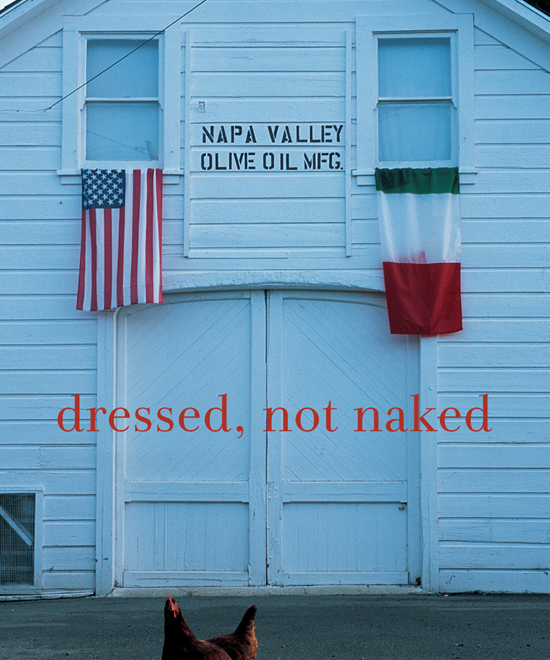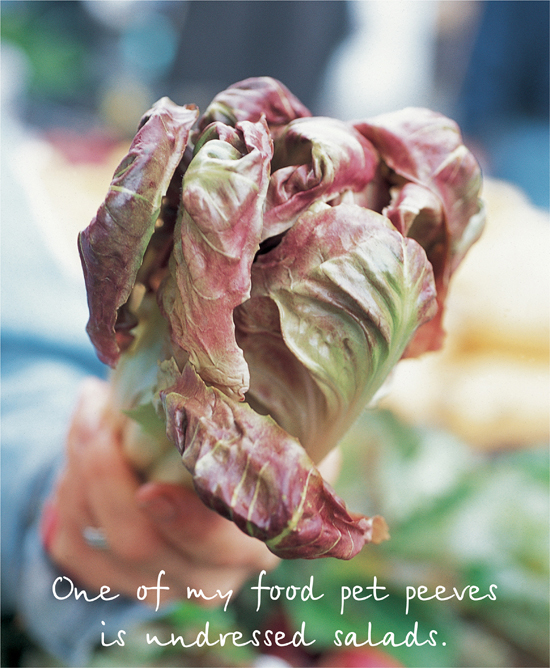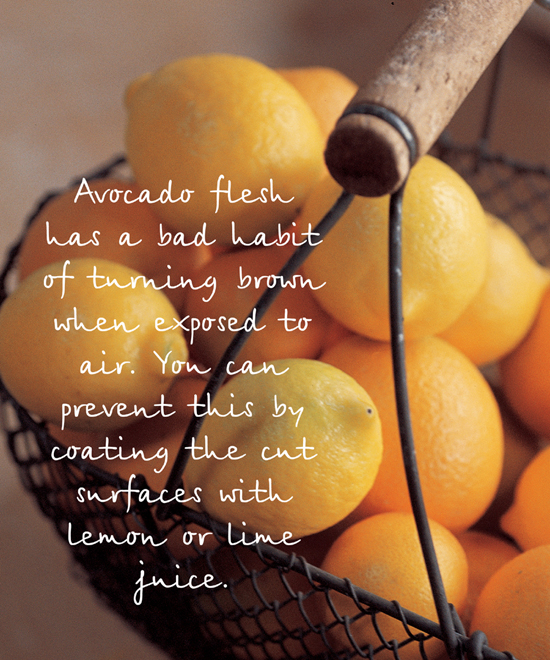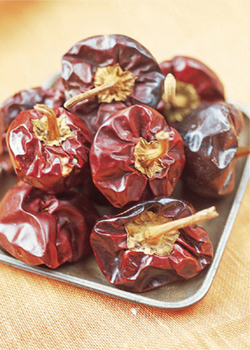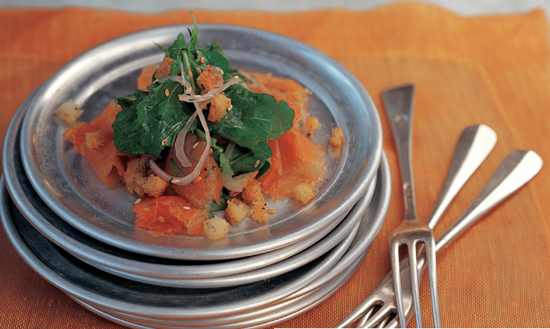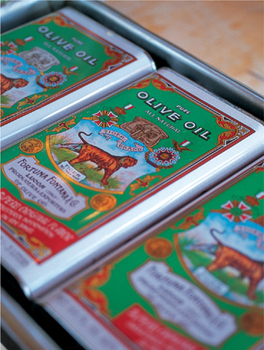chapter 2: dressed, not naked
In this chapter you will find refreshing light dishes to help balance out your menu. Featured are cool salads using a variety of greens and fruit or seafood, along with several suggestions for doing grilled vegetables. Each recipe comes with its own dressing or sauce. One of my food pet peeves is undressed salads. Make sure you dress your salads before you plate them. Most of these sauces and vinaigrettes can be done ahead, and then you just need to dress the dish at the last minute, when you’re ready to serve. My kind of party dish!
If you’re going to fire up the grill to prepare other parts of your meal, try doing your vegetables on the grill, too. It’s quick and easy, and the results are sure to please. Depending on seasonal availability, you could do the Grilled Baby Leeks and Spring Onions or the Grilled Radicchio and Scallions recipes. Asparagus is great whether you grill it or sear it in a hot skillet on the stove (see the recipe called Seared or Grilled Asparagus, which gives two options for dressing the asparagus, an aioli flavored with white truffle oil and a brown butter vinaigrette).
The Avocado-Papaya Salad is on the menu at Cindy’s Backstreet Kitchen—not just because I’m addicted to it, which I am, but because everybody raves about it. Sometime in your life you should make it, and see what all the fuss is about.
Tuna Tartare with Cucumber Salad and Avocado
Tuna Tartare with Cucumber Salad and Avocado
Serves 6
This cool, elegant, Japanese-inspired appetizer is great in the summer, especially if you have cucumbers, sweet red onions, and chiles fresh from your garden (or from your favorite farmers’ market). For an hors d’oeuvre party you could serve the tuna on crackers, such as the Crispy Sesame Crackers in the Mustards Grill Napa Valley Cookbook. And of course you could feature it as presented below in any small-plates meal.
It takes a bit of time for the cucumber to “weep,” and the wasabi paste needs to sit for at least 30 minutes before being used, but everything can be done ahead of time. Then final assembly will take just a few minutes.
Wasabi is a Japanese horseradish. For this dish, we mix wasabi powder with water to make the wasabi paste. You could buy a tube of ready-mixed wasabi paste instead, though you should check out the label to see if it has been loaded up with additives. Wasabi powder and paste are both easy to find at Asian markets. If you’re really lucky, you might find fresh wasabi roots, and could try grating your own paste. Fresh wasabi roots are much smaller than Western horseradish roots, dark brown on the outside, and bright light green inside.
12 ounces sushi-grade ahi or albacore tuna
2 tablespoons wasabi powder
¼ to ½ cup water
1 English cucumber, unpeeled, sliced paper-thin
2 teaspoons kosher salt
2 jalapeño chiles, stemmed, seeded, and julienned
3 red Fresno chiles, stemmed, seeded, and julienned
½ medium-size red onion, thinly sliced
2 tablespoons rice vinegar
2 tablespoons extra virgin olive oil
¼ cup tamari
¼ cup rice vinegar
¼ cup mirin
12 slices avocado
2 tablespoons toasted sesame seeds
Cut the tuna into tiny dice, ¼ inch or smaller. Put it in a bowl, and set the bowl over ice in order to keep the fish well chilled. Refrigerate until needed, up to 2 hours maximum.
In a small bowl, combine the wasabi powder with just enough of the water to make a drizzleable paste. Mix well, cover, and set aside. Let it sit for at least 30 minutes before using. If it thickens too much add a few drops of cold water to thin.
Spread the cucumber slices over a baking sheet and sprinkle them with the kosher salt. Let them sit for 30 minutes to draw out the excess moisture. Combine the chiles, onion, rice vinegar, and olive oil in a mixing bowl large enough to hold the cucumbers, and keep refrigerated until needed. After 30 minutes, pat the cucumbers dry with paper towels and toss them into the bowl with the chiles and onions.
Mix the ingredients for the San Bai Su Drizzle together in a small bowl. Chill 6 medium-small plates in the fridge.
, drizzle the chilled plates with some of the wasabi paste, then gently measure out ⅓-cup portions of tuna and turn them out onto the center of each plate. Place three mounds of cucumber salad about, and drizzle with San Bai Su. Cross 2 slices of avocado on top of each portion of tuna, and sprinkle the sesame seeds over all.
Because the tuna is going to be served raw, it’s very important to buy the very best quality. If you’re
buying ahi, it should be deep red, not a cherry red or candy-apple look that is achieved by gassing the fish with carbon monoxide. You definitely don’t want that. Pass it up if the blood line is brown rather than red, or if the flesh has soft spots or dimples. Albacore tuna is lighter in color, but equally delicious. For both, look for clear, firm flesh with a clean, fresh smell. Tell your fish purveyor you’re serving the tuna raw, and you want sushi- or grill-grade tuna.
Hearts of Romaine, Watercress, and Avocado Salad with Erasto’s Red Jalapeño–Lime Vinaigrette
Hearts of Romaine, Watercress, and Avocado Salad with Erasto’s Red Jalapeño–Lime Vinaigrette
Serves 6
The color contrast in this salad—from the light green of the hearts of romaine and the dark green watercress to the tiny pieces of red jalapeño—really says Christmas to me. At the restaurants we use a product called living watercress, which is milder than most commercially grown watercress; but if you like things a bit more peppery, as I do, stick with regular watercress. The stems of living watercress are edible, but with regular cress, coarse stems need to be removed. If you can’t find perfectly ripe avocados, papaya or mango slices would be nice instead.
2 tablespoons sugar
¼ cup freshly squeezed lime juice
2 red jalapeño or Fresno chiles, stemmed, seeded, and minced
¼ teaspoon salt
¼ teaspoon freshly ground black pepper
3 shallots, minced
¼ teaspoon toasted ground cumin seeds
1½ cups extra virgin olive oil
3 hearts of romaine
2 cups watercress
1½ avocados, pitted and peeled
3 tablespoons toasted pumpkin seeds
, combine the sugar and lime juice, and mix until the sugar dissolves. Add the jalapeño, salt, pepper, shallots, and cumin; whisk until the salt dissolves. In a slow, steady stream, whisk in the olive oil till the dressing is well emulsified. Keep refrigerated.
When you’re ready to serve, cut the romaine hearts into quarters lengthwise and put them in a large bowl. If you’re using living watercress, trim off the roots. For regular watercress, trim off the coarse stems. Set the watercress aside.
, gently toss the romaine with enough dressing to coat. Cross 2 wedges of romaine on each plate. Using the same bowl, toss the watercress with a little more of the dressing, and sprinkle some watercress over the romaine. Cut each half avocado into 6 lengthwise slices. Arrange 3 slices of avocado over each salad, then finish with a sprinkling of pumpkin seeds and a drizzle of additional dressing.
Avocado-Papaya Salad with Papaya Seed Dressing
Avocado-Papaya Salad with Papaya Seed Dressing
Serves 6
My mom was always making avocado-grapefruit salads, so whenever we serve this salad, it reminds me of her. In fact, this recipe comes from a very old cookbook my mom gave me years ago. Our version receives raves at Cindy’s Backstreet Kitchen. The fantastic color has a lot to do with it, with the orange-red of the papaya and the soft green of the avocados. It’s a favorite among the staff as well.
For this dish, you want ripe papayas, with tender but not mushy flesh. The skin should be bright yellow with a few mottled spots, and the fruit should be sweet-smelling and aromatic. The papaya has small black seeds that look a little like capers or caviar. These seeds have a little heat in them, and they can be used for a garnish or to add a little zip to salad dressings.
If you have mangoes that are ripe, they are wonderful here as well. If you would like to try something other than hazelnuts, pecans, almonds, macadamias, or pistachios would all be really nice, but I don’t think walnuts would work.
1 or 2 papayas (about 1 pound)
2 tablespoons papaya seeds
3 tablespoons freshly squeezed lime juice
3 tablespoons rice vinegar
1 tablespoon plus 2 teaspoons honey
⅔ cup olive oil
2 small cloves garlic
½ teaspoon toasted ground cumin seeds
1 teaspoon sweet paprika
¼ teaspoon salt
Freshly ground black pepper
2 cups baby mâche, or endive, lamb’s lettuce, butter lettuce, or Bibb lettuce
2 cups baby arugula
2 or 3 avocados, peeled, pitted, and sliced
1½ tablespoons toasted hazelnuts, coarsely chopped
Freshly ground black pepper
1 lime, cut into 6 wedges
Split the papayas in half lengthwise. Scoop out the seeds, and set aside 2 tablespoons of seeds for the dressing, picking off any membranes attached to the seeds. Peel the papayas and cut crosswise into ¼-inch-thick slices.
, combine all the dressing ingredients in a blender and blend until smooth.
To serve, dress the mâche and arugula with half the dressing, and pile this in the center of 6 salad plates. Alternate slices of avocado and papaya across the greens and drizzle with the remaining dressing. Sprinkle on the nuts and some freshly ground black pepper, and place lime wedges on the side. Or if you prefer, you could compose the plate with the fruit on the bottom and the greens on top. Either way, it’s yummy.
Baby Octopus Salad with Malagueta Chile Relish
Baby Octopus Salad with Malagueta Chile Relish
Serves 6
Because my allergy to crustaceans has limited what I can eat in the shellfish family, I have developed a love for the ones that are safe for me to eat, such as cuttlefish, squid, and especially octopus. In this dish, the combination of flavorful baby octopus meat and spicy-hot chile sauce over crisp greens and herbs is just perfect.
Baby octopus is very tender, but the younger and smaller the better, so try to stick with ones that are about one to two inches in length. You can usually find frozen baby octopus in ethnic markets, particularly Spanish, Japanese, and Italian ones. You might even find fresh octopus there, too. When picking out fresh octopus, go for the ones that are translucent gray, moist, slimy, and bright-eyed. They should smell clean and slightly of the sea. Both Pacific and Atlantic octopus will work for this recipe. Don’t forget, the tentacles are the best part to eat.
A malagueta
is a Brazilian chile that is used both green (unripe) and red. They are tiny and round, like capers, and when ripe they are super-hot. They are used a lot in sauces in Brazil, and are also served as a side dish or condiment with meat and black beans. Fresh malaguetas
are hard to find, but if you have a good South American market nearby, you should at least be able to find them in jars, packed in vinegar or in cachaça,
a Brazilian liquor made from sugarcane. Malaguetas
are a little fruity, as are habaneros, so habaneros would be a good substitute if you can’t find malaguetas.
Or use serranos in a pinch.
6 malagueta chiles or 1 or 2 habaneros or serranos, seeded and minced
2 tablespoons aged red or white wine vinegar
¼ cup peanut or olive oil
1 small sweet onion, minced
1 teaspoon finely grated peeled fresh ginger (about ¼ inch piece)
¼ teaspoon sea salt
1 pound baby octopus
Juice of 1 lime
½ large red onion, minced
¼ cup minced fresh Italian parsley, leaves and tender stems only
2 tablespoons minced cilantro leaves
2 tablespoons minced pasilla chile
2 tablespoons minced red bell pepper
⅓ generous cup olive oil
½ teaspoon salt
¼ teaspoon freshly ground black pepper
6 nice butter lettuce leaves, for bowls or cups
6 slices avocado
1 lime, cut into 6 wedges
, combine the chiles and the vinegar and let marinate for at least 1 hour (or as long as 24 hours, if you wish). If you are using cured chiles, skip this step and instead rinse these already-marinated chiles slightly, then proceed with the rest of the recipe. When you are ready to put the relish together, heat the oil over medium-low heat in a sauté pan and sweat the onions and ginger 2 to 4 minutes, till they are translucent and tender. Scrape them out onto a plate and let cool. Once cooled, combine them with the marinated chiles and season with salt. Reserve until needed.
, you’ll need to clean it yourself. Turn the head inside out and scrape off the viscera and other organs. Trim away the small bone at the bottom of the head and remove the beak. Check the tentacles for sand, and rinse the entire octopus well. (Frozen octopus is usually cleaned already, in which case you can skip this step.)
Bring a big pot of salted water to a boil; reduce to a slow simmer and add the octopus. Cook 45 minutes to 1 hour, until tender but still chewy when you bit into it (test it by cutting off a small piece to taste). When finished, drain and rinse the octopus, and allow it to cool slightly. Cut the head and tentacles into nice bite-size pieces.
Put the lime juice, onion, parsley, cilantro, pasilla, bell pepper, and olive oil in a large bowl and mix well. Add the octopus, stir everything around well, and season with the salt and pepper.
, scoop spoonfuls of the octopus salad into the lettuce leaves, and top each with some of the relish and a slice of avocado. Serve with lime wedges on the side.
Shrimp, Crab, and Octopus–Stuffed Avocado with Cilantro-Caper Mayonnaise
Shrimp, Crab, and Octopus–Stuffed Avocado with Cilantro-Caper Mayonnaise
Serves 6
You can usually find cooked octopus in supermarkets that have a good seafood department. If you can’t find octopus, you could substitute an additional four ounces of shrimp or crab in the stuffing. For smaller portions, cut the avocado into quarters lengthwise. Place a mounded tablespoonful of the seafood stuffing in the hollow where the pit was and top with some of the Cilantro-Caper Mayonnaise. If you end up with any extra mayonnaise, it is excellent on almost any grilled vegetables.
Avocado flesh has a bad habit of turning brown when exposed to air. You can prevent this by coating the cut surfaces with lemon or lime juice, but it also works to dunk the sliced avocado in ice water, remove it, and set it on a paper towel until you need it.
16 ounces shrimp, cooked in their shells
8 ounces fresh crabmeat (about 1 cup)
1 cup mayonnaise
2 tablespoons minced cilantro leaves
1½ to 2 tablespoons capers, rinsed and minced
1 clove garlic, minced
¼ teaspoon salt
⅛ teaspoon freshly ground black pepper
Juice of 1 lime
Pinch of salt
Pinch of freshly ground black pepper
3 tablespoons olive oil
3 avocados
3 cups shredded iceberg lettuce
2 pints cherry tomatoes, halved
1 or 2 limes, cut into wedges
Peel and devein the shrimp, and coarsely chop them up. Put them in a medium-size bowl. Slice the octopus into ¼-inch-thick rounds, and add to the bowl along with the crab. Cover and refrigerate until needed.
, combine all the ingredients in a small bowl and mix well. Keep chilled until needed.
, combine the lime juice, salt, and pepper, then whisk in the olive oil in a steady stream. Continue whisking till well emulsified.
Cut the avocados in half lengthwise and remove the pits. Using a big spoon, scoop out the avocado halves as neatly as you can, being careful to keep them intact. Dunk them quickly in ice water to keep them from turning brown, and drain on paper towels.
, dress the lettuce with just enough of the vinaigrette to coat lightly. Divide the lettuce among 6 bowls and top each bed of lettuce with an avocado half. Combine the seafood with the tomatoes and just enough mayonnaise to coat lightly, and mix gently. Scoop some of this salad into each avocado half. Place a small dollop of the remaining mayonnaise on top and drizzle a bit of vinaigrette about. Serve with wedges of lime on the side.
Grilled Baby Leeks and Spring Onions with Garlicky Romesco Sauce
Serves 6
This recipe was inspired by a one-of-a-kind festival that’s held each year in Catalonia to celebrate the calçot, a long, skinny white onion that’s something like a cross between a leek and a spring onion. The specialty of the festival is slow-grilled calçots served with plenty of romesco sauce, one of Spain’s great sauces. You can’t get calçots here, but it doesn’t matter—spring onions and leeks will do just fine. If you can’t find baby leeks, use all spring onions or scallions.
In my library of cookbooks, there are probably twenty or thirty different recipes for romesco sauce, many of which I have worked with in variations over the years. All romesco sauces contain, in varying proportions, chiles, tomatoes, garlic, bread (as a thickener), and olive oil. They also contain ground almonds, which give the sauce a great texture and make it unique. The recipe below, which is my current favorite, goes heavy on the garlic. You could make a simpler version of it by substituting three to four cloves of fresh garlic for the head of roasted garlic. But if you want to go for broke, you’ll need to roast a head of garlic first (see the directions below).
Use a fruity extra virgin olive oil from Spain, if you can. I’ve made this sauce with dried New Mexico chiles from the local grocery store and with choricero
and guindilla
chiles from The Spanish Table. In a pinch, I once made a nice variation with roasted, peeled red bell peppers and pimientos. Dried ñora
peppers from Spain would be the very best.
Romesco
sauce is really best made a day ahead. Any leftovers would be good with steamed vegetables, poached or grilled poultry, rabbit, pork, shellfish or finfish … you name it.
1 head garlic
1 cup plus 1 tablespoon fruity olive oil
2 dried choricero or guindilla chiles (or dried ancho or New Mexico chiles)
½ cup almonds
1 slice rustic white bread
1 tomato, peeled and seeded
2 tablespoons red wine vinegar
2 tablespoons water
½ teaspoon salt
⅛ teaspoon cayenne pepper or crushed dried red pepper
12 baby leeks
6 small spring onions or scallions
Additional olive oil, for coating
, preheat the oven to 300°F. Break the head of garlic apart and trim off the root ends of the cloves. Put the unpeeled cloves in an ovenproof dish. Sprinkle with ½ cup of the olive oil and roast 45 minutes to 1 hour, until the garlic cloves are golden and soft.
Increase the oven heat to 375°F to prepare the chiles and almonds. Put the chiles and almonds on separate baking sheets and place them in the oven to toast. In 2 to 3 minutes, the chiles should to begin to release their aromas and start softening up, at which point remove them from the oven. Leave the almonds in for about 7 minutes, until golden brown, then remove and set aside. Put the chiles in a bowl or pot with just enough warm water to cover and soak for 10 to 15 minutes, until tender. Drain, reserving the soaking liquid.
Heat 1 tablespoon of the oil in a small skillet over medium-high heat. When the oil is hot, add the bread and fry until golden brown on both sides. Set this aside.
To make the romesco sauce, squeeze the cloves of garlic, popping the pulp out into a food processor. Add the bread, chiles, almonds, tomato, vinegar, water, salt, and cayenne, and blend until everything is well mixed and coarsely chopped. Continue blending while slowly adding the remaining ½ cup of olive oil in a steady stream. You don’t want the sauce too creamy, so stop before you reach that point. You want a robust, rustic sauce that’s a bit chunky and will adhere to whatever you dip into it. Thin with a little of the reserved chile soaking liquid only if necessary. Store in the refrigerator until needed. The sauce tastes better at room temperature, but it’s good cold as well.
Trim off the root ends of the leeks, then make 4 lengthwise cuts in each, being careful not to cut all the way through at the base. You want the leeks to fan out, but not fall apart. Rinse them well, as they can be very sandy. Trim the root ends of the spring onions and rinse well. Coat the leeks and spring onions with olive oil and place them over a low fire. Grill them slowly until they are very soft and tender on the inside and a bit charred on the outside, 5 to 6 minutes for the spring onions, 10 to 15 minutes for the leeks. Turn them as you grill them, and check for doneness with a knife, piercing them at their thickest point. Serve them warm from the grill with plenty of
romesco sauce for dipping.
Grilled Radicchio and Scallions with Black Olives
Serves 6
Radicchio might be an acquired taste, but it’s one of my favorites. I especially love radicchio when it is slowly grilled over a low fire. To tone down any bitterness, soak the radicchio in ice water first, then be sure you cook it long enough to tenderize it and let its natural sweetness develop—if it gets a bit charred, that’s a plus.
I usually use the firm round Chioggia or Verona radicchio. These are two of the most common ones sold. Or you could try the Treviso radicchio, which has long narrow leaves and looks sort of like a red-and-white Belgian endive. It’s a little milder than the other two. Whichever kind you use, the trick in preparing them is to trim off just a tiny amount of the base, leaving the core intact to hold the wedge together on the grill.
This is a good side dish to prepare when other parts of the meal are also coming off the grill. It’s also good with grilled bread spread with Best-Ever Tapenade.
2 or 3 heads radicchio
6 scallions
Juice of 1 lime
5 tablespoons extra virgin olive oil
¼ teaspoon salt
⅛ teaspoon freshly ground black pepper
2 tablespoons balsamic vinegar
¼ teaspoon salt
⅛ teaspoon freshly ground black pepper
6 tablespoons extra virgin olive oil
3 or 4 dozen marinated or salt-cured black olives
3 tablespoons shaved aged goat cheese or dry-aged Monterey Jack, Parmesan, or pecorino cheese
2 tablespoons minced fresh parsley or fresh basil
Cut each head of radicchio in half, from the core to the outside, to make sure there’s enough core to hold the wedges together. Cut each half into 3 wedges, again making sure each wedge has a bit of the core for support. Soak the radicchio in ice water for 20 to 30 minutes, then drain it well. Place the radicchio in a flat container. Trim the roots off the scallions and remove 1 or 2 of the outer layers. Toss the scallions in with the radicchio. To make a marinade, combine the lime juice, olive oil, salt, and pepper in a small bowl, whisking gently but well. Thoroughly coat the radicchio and scallions with this, and let them marinate at least 30 minutes but no more than 2 hours.
, put the balsamic vinegar, salt, and pepper in a small bowl, and whisk to combine. Whisk in the oil. Set this aside. Later you will be adding chopped grilled scallions to this base to complete the dressing.
, put the scallions on first, and cook them until fork-tender, about 5 minutes. When they’re done, chop them finely and toss them into the balsamic vinegar dressing. Grill the radicchio over a medium-hot fire, turning the wedges often, until caramelized at the edges, 8 to 10 minutes. The radicchio should be tender, but not so soft as to fall apart, and there should be a little bite to it.
, place 2 or 3 wedges of radicchio on each small plate, and drizzle with the balsamic-scallion dressing. Garnish with the olives, cheese, and parsley or basil.
New French Café Gravlax
Serves 8 to 10
When I left Chicago in 1978, my idea was to go home to Minnesota, spend time with my dad, and take French lessons. My plan was to go to France and spend a year there cooking. But it never happened. Instead, I ended up moving first to San Francisco and then to Napa to open a bunch of restaurants. For the nine months I was home, I had a blast. In addition to the French lessons and fishing with my dad, I worked in a hip French café in the “arty” part of town. It was run by Pam Sherman and Lynn Alpert, two vibrant women with great aesthetics, who were smart enough to give their staff enough rope to try stuff out but not enough to hang themselves. I don’t think the café still exists, but I remember it fondly. That’s where I learned about gravlax.
Making gravlax requires no cooking and very little work—the salmon is cured with salt, sugar, and dill in the refrigerator. The curing process takes three days, though, during which you only need to turn the fish and pour off any liquids that have accumulated. Then you slice and eat. There are probably ten thousand ways to enjoy gravlax. For the simplest presentation of all, serve the gravlax with croutons, breadsticks, flatbread, or plain or rye crackers. For this recipe, you need only two to three ounces per person at most. You could offer a mustard sauce, and dress the plate up with a little fresh dill. You can use almost any sturdy bread for the croutons. Try a bâtard, sourdough, baguette, or rye bread. See the sidebar for other serving suggestions.
This recipe is for two pounds of salmon. Adjust it for however much fish you have. Go for uniformly thick fillets of salmon cut from the center. Don’t use the tail end of the fish because it will cure too quickly.
¼ cup kosher salt
½ cup sugar
2 teaspoons freshly ground white pepper
2 pounds wild king salmon fillets, skin on
½ to ¾ bunch fresh dill weed, coarse stems removed
¼ cup sherry vinegar
¼ teaspoon sea salt
Several grindings of black pepper
¼ cup sesame oil
½ cup extra virgin olive oil
2 cups arugula, watercress, or baby Japanese mustard greens
2 tablespoons chopped fresh dill weed
¼ cup finely minced fresh chives
2 shallots, sliced
1 cup tiny croutons (¼-inch dice or smaller)
¼ cup toasted sesame seeds
, combine the salt, sugar, and pepper in a small bowl and mix well. Place the salmon, skin side up, on a long cutting board. With a sharp knife held so that the blade is almost flat against the fish, make 3 or 4 shallow half-moon-shaped slits horizontally across the fish. The cuts should just graze the skin but not go deeply into the flesh. An index finger stuck under the flaps of mostly skin should go in to about the second knuckle. Take half of the salt-sugar mixture and rub it into the cuts and across the whole surface. Now tuck half of the dill into the cuts and lay a few extra pieces over the whole fish. Turn the fish over and coat it with the remaining salt-sugar mixture, and sprinkle on what’s left of the dill.
Wrap the salmon very tightly in plastic wrap and place it between two plates. Put a 1- to 2-pound weight, such as a can or a bag or two of beans, on the top plate. Refrigerate for 3 days, turning the fish once a day and pouring off any juices. If you want the gravlax less salty and firm and a bit more medium-rare, cure it for just 2 days.
When the salmon is firm to the touch, scrape off the salt, sugar, and dill, starting from the tail end and working up. For slicing, I prefer the look of a wide horizontal slice to a straight-down cut. Using a very long, thin slicing knife, run the blade across the surface of the fish to get the very thinnest slices you can. You should be able to see the knife through the flesh. If you come to a point where you can no longer cut nice thin slices, dice the remainder for chowder, salad, pizza topping, or best yet, a cook’s snack.
, whisk together the vinegar, salt, and pepper until the salt has dissolved. Then gradually whisk in the oils, and continue whisking until the dressing is well emulsified.
When you’re ready to serve, mix together the arugula, dill, chives, shallots, and just enough of the vinaigrette to coat. Place a slice or two of gravlax on each small plate, mound a bit of greens over each serving, and sprinkle with croutons and toasted sesame seeds.
There are endless ways to serve gravlax. I thought I’d include some of my favorites in case you wanted to get crazy and do a variety of presentations.
• In the summer it’s nice to serve gravlax with tiny corn cakes or muffins and a drizzle of Lime Crème Fraîche or sour cream.
• Here’s a good winter option. Arrange a layer of thinly sliced gravlax on small plates and sprinkle with tarragon or chervil, freshly ground black pepper, and sea salt. Put a mound of grapefruit and/or orange sections and avocado slices in the center, then top all with some minced shallots and a drizzle of extra virgin olive oil.
• Drape tiny slivers of gravlax over deviled eggs or stir some into scrambled eggs.
• Or how about slices of gravlax topped with some sharp, peppery greens such as wild baby arugula or watercress, sprinkled with scallions or very finely sliced shallot, freshly ground black pepper, and a little chervil or tarragon? Finish this one with a drizzle of crème fraîche or thinned sour cream, extra virgin olive oil, and a couple pinches of sea salt.
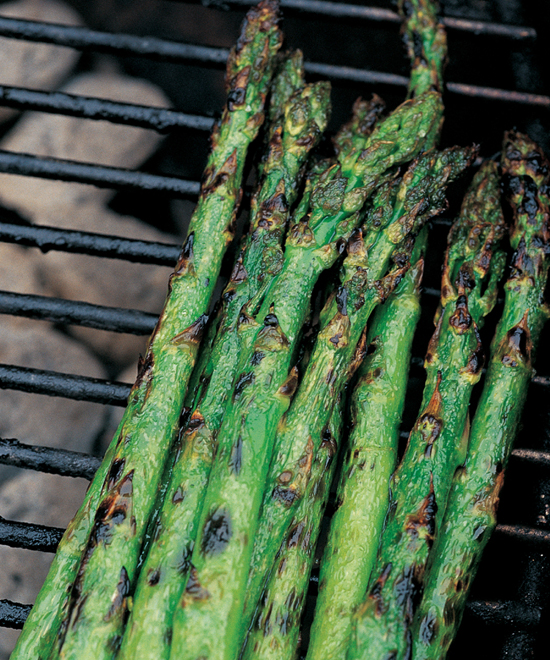
Seared or Grilled Asparagus with Two Sauces
Seared or Grilled Asparagus with Two Sauces
Serves 6
If you check through the recipes in this book, it will be pretty obvious to you that asparagus is one of my favorite things, as it turns up in everything from baked Brie to Thai fish cakes. Several years ago, I even started growing my own asparagus. It took a good three years for the bed to establish itself, but then, look out! For a few short weeks every spring, it’s asparagus in some form for breakfast, lunch, and dinner! Of course, you don’t have to grow your own asparagus to take part in the craziness. Just remember that the season is short, so when asparagus shows up in your market, don’t hesitate.
There are probably a million ways to cook asparagus, but sometimes simplest is best, as in this recipe: asparagus spears cooked over a wood fire or on a coal-fired grill, a cast-iron grill pan, or an electric griddle, and dressed either with Brown Butter Vinaigrette or with White Truffle Oil Aioli (both are really good). If you opt for grilling, a grilling basket would be very helpful for keeping the asparagus under control.
1½ pounds pencil-thin asparagus
3 tablespoons olive oil
¼ teaspoon salt
⅛ teaspoon freshly ground black pepper
Snap off the ends of the asparagus where they break naturally. Coat the spears with the olive oil, and sprinkle with the salt and pepper. Let marinate at room temperature for 30 minutes to 2 hours. Grill or pan-sear the asparagus 2 to 4 minutes, till bright green and just tender, turning the spears as they cook.
, arrange the asparagus as you like, and drizzle with warmed Brown Butter Vinaigrette or White Truffle Oil Aioli.
1 teaspoon minced shallots
1 teaspoon minced garlic
1 teaspoon Dijon mustard
3 tablespoons balsamic vinegar
¼ teaspoon salt
Pinch of freshly ground black pepper
4 tablespoons butter
1 tablespoon freshly squeezed lemon juice
5 tablespoons extra virgin olive oil
3 teaspoons capers (optional)
2 tablespoons olive oil (optional)
1 teaspoon minced fresh parsley leaves, rinsed and squeezed dry
, combine the shallots, garlic, mustard, vinegar, salt, and pepper in a small bowl, and set it aside. In a wide-bottomed sauté pan, cook the butter over high heat, stirring constantly, until it turns a nutty caramel-brown. Mix in the lemon juice and remove from the heat. Slowly whisk the butter into the shallot mixture, then whisk in the extra virgin olive oil. Continue whisking until well emulsified. Keep the vinaigrette at room temperature, and warm it up before serving.
If you opt for the garnish of crispy capers, rinse the capers, then heat the olive oil in a small sauté pan over medium-high heat and fry the capers until they are crisp and have opened up. Scoop the capers out with a slotted spoon and drain on a paper towel.
, warm up the vinaigrette, and pour it over the asparagus. Finish with a sprinkling of parsley and capers, if desired.
Truffle oil, the darling of a lot of fancy restaurants, can be quite tasty if not overused. In this case, just a tablespoon or two makes a big difference in a simple aioli—that and a little chopped tarragon. Most truffle oils are made by infusing olive oil with truffles, but the skinny is that there is no “pure” one sold, and none made with white truffle essence, as this essence is very volatile and won’t hold. Instead, they contain some “nature-identical” products that taste like white truffle but are made with a chemical base. Some of the black truffle oils are actually made with real black truffles, but they are probably goosed as well.
2 large egg yolks
1 tablespoon champagne vinegar
2 cloves garlic
1 or 2 pinches crushed dried red pepper
½ teaspoon salt
⅛ teaspoon freshly ground black pepper
2 tablespoons (lightly packed) chopped fresh tarragon leaves and tender stems
½ cup olive oil
¼ cup extra virgin olive oil
1 to 2 tablespoons white truffle-infused oil
1 cup tiny croutons (¼-inch dice; optional)
, put the egg yolks, vinegar, garlic, crushed red pepper, salt, and pepper in a food processor and blend until the mixture thickens and turns light lemon-yellow in color. With the machine running, add the tarragon, then slowly drizzle in the olive oils and the truffle oil until all are well incorporated. Taste for seasoning. Thin with water, if desired, to a drizzleable consistency.
, arrange the asparagus on plates, drizzle with some aioli; sprinkle with tiny croutons, if desired.
Herbed Goat Cheese and Walnut Log with Garden Greens
Serves 6
This is a light, bright dish that you can make any time of the year if you select the herbs and greens according to seasonal availability. In the spring, I’d use celery leaves, dill, and tarragon for the cheese log and a mix of watercress leaves, arugula, and butter lettuce for the salad. In the summer, it could be basil and garlic chives for the log, with frisée and arugula for the greens. In the winter, try parsley and chervil, with two or three varieties of radicchio as the greens mix. The version below is a spring rendition.
For the greens, I like to use a vinaigrette made with walnut oil, to pick up on the flavors of the walnuts on the cheese log. Walnut oil is highly flavorful and very aromatic, but it becomes rancid quickly, so buy it in small bottles and keep it refrigerated. Try different brands to discover your favorite: I think the oils made with roasted nuts are best. Several are produced in California that are just as good as the ones from France. Walnut oil is too strong to be used alone in a vinaigrette; it needs to be combined with a mild olive oil. The exact proportions of walnut oil to olive oil are negotiable.
Long, angular croutons look the best, so when cutting the bread, try for a pretty dramatic diagonal on the cut. And as for the vanilla, after scraping the beans into the dressing ingredients, don’t just throw out the pod. Toss the scraped pod into a small bowl of sugar for vanilla sugar, or put it in a little jar of brandy for vanilla brandy. You could also keep it in your freezer and use it the next time you poach any kind of stone fruit.
8 ounces soft fresh goat cheese, at room temperature
½ cup minced celery leaves
2 tablespoons minced fresh tarragon
2 to 3 tablespoons minced fennel fronds or fresh dill weed
½ teaspoon freshly ground black pepper
Juice and finely grated zest of ½ lemon
1 cup chopped toasted walnuts
½ vanilla bean
Juice and grated zest of 1 lemon
Sea salt
Freshly ground black pepper
¼ cup walnut oil
¼ cup olive oil
6 thin slices of baguette or levain-style bread, cut diagonally
Olive oil, for brushing
3 cups mixed watercress (coarse stems removed), arugula, and butter lettuce
, combine the goat cheese, celery leaves, tarragon, fennel, pepper, and lemon juice and zest; mix well. Roll the mixture into a 1½-inch-diameter log, wrap in plastic, and chill until firm, at least 1 hour. Once chilled, roll the log in the nuts, pressing so they adhere to the cheese. Wrap again in plastic and chill until needed.
, split the vanilla bean open and scrape the seeds into a small bowl. Add the lemon juice, lemon zest, salt, and pepper, and stir until the salt has dissolved. Gradually whisk in the oils, and continue whisking until well emulsified. Set aside until needed.
Preheat the oven to 375°F. Brush the bread with olive oil. Place the bread on a baking sheet, and bake until toasted and golden brown.
, cut the cheese log into ½-inch-thick rounds. Briefly whisk the dressing once more, and toss the greens with just enough of it to moisten. Pile some greens in the center of each small plate and top with a slice of cheese, then drizzle over a little of the remaining dressing. Sprinkle any additional walnuts about and place a crouton off to the side on each plate.
